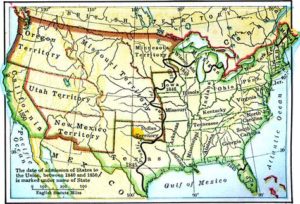
Map Showing Utah Territory
Though most people going West to follow their dreams (or spouses) into U.S. Territories might have been particularly hardy or adventurous, some succumbed to mental illness along the way or after arriving. These insane were taken either to county poorhouses or admitted to private institutions in Salt Lake until the legislature created the Territorial Insane Asylum in Provo. (Utah did not become a state until January 4, 1896.) The bill to create the asylum was introduced in February, 1880, and the institution opened its doors to admit patients five years later on July 15, 1885.
Of course this insane asylum admitted the insane, but it also accepted feeble-minded patients and non-insane epileptics who were capable of improvement. It would not accept the feeble-minded who couldn’t improve, the senile, “a person in an unconscious condition,” infants, children under ten, and people suffering from contagious diseases.

State Mental Hospital in Provo, Utah, circa 1900, courtesy Utah Department of Human Services
Whether the rules were actually carried out or not, Utah seemed to protect its citizens a bit better than some other states. Anyone wanting a person committed had to fill out an informational form and then face an examination under oath before the district judge. If he were satisfied that there was “reasonable cause” for a person’s admittance to the asylum, the judge held a hearing that required the district attorney to represent the state. The judge had to “summon two practicing physicians” to certify under oath whether or not the person in question was insane. Additionally, any citizen (of the county in which the hearing took place), friend, or relative could oppose the application and appear at the hearing with counsel.

Patients at Utah Territorial Insane Asylum, circa 1900s, courtesy Utah State Hospital Museum
Anyone could submit an affidavit to the Board of Insanity saying that a committed patient was not insane or not a proper person to be placed in an asylum. The Board then had to make inquiries. If the person was found to be sane, he/she would be discharged. However, if the patient was deemed insane, the judge “must order his continued detention, and may order the parties demanding the inquiry to pay its cost.” [Emphasis added.]
The latter provision very likely deterred indigent patients and their friends from contesting even unfair commitments to the institution.